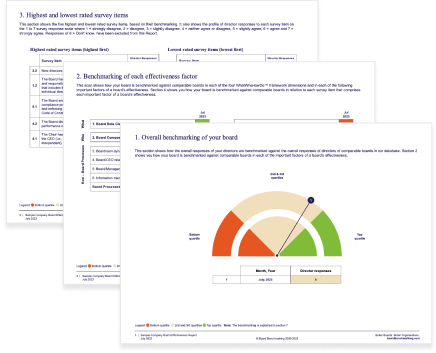How boards can prioritise purpose, strategy and execution
Few would argue that setting the organisation’s strategic direction and overseeing its execution is a board’s core business and main reason for existence. However, in an environment of increased regulation and societal expectations, boards often get bogged down in their other critical responsibility – actively managing corporate governance and risk. It is necessary and right to ensure that the organisation is upholding ethical standards, legal compliance, and governance best practices, as well as identifying and mitigating risks that could threaten the organisation’s future. The problem arises when the volume of work here is so overwhelming that it crowds out the more creative and value-adding work necessary to ensure the organisation is achieving its purpose, following a strategy that adds long-term value, and making strategic pivots as the external environment changes.
Almost without exception, boards tell us that they need to recalibrate the balance between strategy and compliance, find a way to focus more on future opportunities and threats, and work out what will give the organisation its greatest advantages, make it more successful, and achieve its strategic goals.
Some boards get much closer to finding the right balance than others. It is a hard thing to achieve and comes from very deliberate thought and action. The most successful boards do the following five things.
5 key practices for balancing purpose, strategy, and execution
Based on insights from over 600 board reviews, here are the key practices that high-performing boards use to balance purpose, strategy, and execution.
1. They follow a carefully designed annual agenda
Successful boards structure their annual agendas with these key elements:
- Setting aside time for deep dives into strategy a few times a year, sometimes in separate strategy sessions.
- Creating space for less structured and open-ended discussions that consider the big picture and megatrends likely to impact the organisation in the next 3-5 years.
- Inviting experts who are known for big picture visionary thinking on relevant topics to join some sessions to help the board and executives imagine different scenarios for the future.
- Moving strategy to the front of the agenda of some board meetings and considering financials or compliance in the middle or latter parts of the meeting
2. They structure board committees effectively
Boards that manage compliance and governance efficiently do so by carefully structuring their committees and ensuring a clear delegation of responsibilities. Common committees include:
- Audit committee – Oversees financial reporting, internal controls, and regulation compliance.
- Risk committee – Manages enterprise risks, cyber security, regulatory and strategic risks.
Some organisations also choose an Environmental, Social and Governance Committee and/or a Technology Committee. Generally, a board would not have more than 3-4 committees – a proliferation of committees can add complexity. If the central board meeting is being overwhelmed with finance and compliance matters, then it would be well worth looking at the structure and functioning of its committees to see how they could improve the situation.
3. They ensure alignment between purpose, strategy and execution
High-performing boards maintain a clear line of sight between these key strategic elements:
- Vision, mission and values – the long-term anchor points guiding their direction over a 5-10-year timeframe.
- Strategic plan and goals – outlining what they want to achieve and how they will achieve it (over a 3-5 year timeframe).
- Business plan and budget – which guide daily actions (updated annually).
In some organisations, there is dissonance between these levels. For example, the vision might be aspirational and humanistic, while the budget might be tough and demanding, and the link between the two might be hard to see. In the most successful organisations, there is a clear line of sight, congruence and alignment between all of these elements.

4. They foster better reporting and dialogue
Strong boards focus on meaningful discussions rather than repetitive reporting. They:
- Set clear and specific goals cascaded through the organisation and prioritise them rigorously so that everyone clearly understands the main objectives.
- Select a small number of key performance indicators carefully and track them regularly.
- Limit time spent on repeating what the board papers have already reported.
- Limit routine updates; they use pre-reads for operational and compliance reports so that meetings can focus on forward-looking strategy.
- Shift from reporting to dialogue.
- Move from passive listening (management presenting slide decks) to active engagement (board discussions, scenario planning).
- Ask about lead indicators of success and what early warning signs of delayed execution need to be monitored.
5. They track execution rigorously
Execution is critical, and successful boards ensure it is effectively managed by:
- Clarifying accountabilities.
- Ensuring projects have the necessary resources.
- Understanding how execution success is recognised and rewarded.
- Identifying obstacles and addressing what is not working.
- Not overly relying on management’s narrative and don’t take management’s updates at face value without challenging assumptions.
- Recognising that people on the ground implement strategy, and engaging with frontline employees and customers to hear the story firsthand, seeing how the strategy impacts them.
- Understanding that execution fails when employees don’t buy in.
- Assessing whether the organisation’s culture supports the strategy and ensuring that incentives are aligned with execution.
Rather than relying solely on management narratives, effective boards challenge assumptions and seek firsthand insights. They know that execution fails when employees lack buy-in, and they work to foster alignment between strategy and workplace culture.
Prioritising purpose, strategy and execution are among the most essential functions of a board. It is what gives the organisation its competitive advantage, positioning it for success far into the future. A board can play a significant role in helping the organisation achieve this by setting the right annual agenda, effectively using its committees, aligning the different elements of purpose and strategy, fostering meaningful conversations and rigorously tracking execution.



